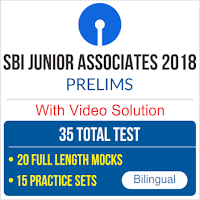Dear Aspirants,
Reasoning Ability is an onerous section. With the increasing complexity of questions, it becomes hard for one to give it a cold shoulder. The only way to make the grade in this particular section in the forthcoming SBI PO Prelims and other banking exams is to practice continuously with all your heart and soul. And, to let you practice with the best of latest pattern questions, here is the Adda247 Reasoning Quiz with the exact same pattern of questions that are being asked in the exams.
Following the study plan for SBI PO Preliminary Examination 2018, the third week ends with practice questions on Miscellaneous topics. To ensure proper preparation of the section we advise you to go through all the questions sincerely and try to attempt each one of them. Afterward, match your solutions and the approach with the one that would be provided later. Practice more and more questions on the same section to enhance your grip over the topics. Following is the Reasoning Ability quiz to help you practice with the best of latest pattern questions.
Check Detailed VIDEO SOLUTION for this Quiz!!
Directions (1-5): Study the following information carefully and answer the questions given below:
P, Q, R, S, T, U, V, W are sitting around a circular table and four of them are facing inside and rest are facing outside the centre but not necessary in the same order. Q sits immediate right to W, who sits opposite to P. V sits second to the left of U. T is an immediate neighbour of U. W and P face in same direction. R and U face in the same direction. T faces inside the centre. R sits second left to W. U and S face inside the centre.
Q1. Who sits opposite to Q?
(a)W
(b) U
(c) R
(d) V
(e) T
Q2. Who sits second to the left of R?
(a) S
(b) T
(c) P
(d) Q
(e) W
Q3. If V and T interchange their positions, then who sits to the immediate left of T?
(a) U
(b) S
(c) P
(d) R
(e) Q
Q4. Four of the following five are alike in a certain way and so form a group. Find the one which does not belong to that group?
(a) P
(b) U
(c) W
(d) Q
(e) V
Q5. What is the position of Q with respect to P?
(a) Second to the right
(b) third to the left
(c) Immediate right
(d) Immediate left
(e) None of these
Directions (6-10): Study the given information and answer the questions:
When a word and number arrangement machine is given an input line of words and numbers, it arranges them following a particular rule. The following is an illustration of input and its rearrangement.
Input: 97 bat 42 ball 68 play 73 hold
Step I: play 97 bat 42 ball 68 hold 73
Step II: bat play 42 ball 68 hold 73 97
Step III: ball bat play 68 hold 73 97 42
Step IV: hold ball bat play 73 97 42 68
Step IV, is the last step of the above arrangement as the intended arrangement is obtained.
As per the rules followed in the given steps find out the appropriate steps for the given input.
Input: 97 english 53 logical 90 reasoning 17 maths 84 quant 26 edhole
Q6. In which of the following step elements ’maths quant 90 edhole 17’ is found in the same order?
(a) Step I
(b) Step IV
(c) Step V
(d) Step II
(e) None of these
Q7. What is the difference between the numbers which are fourth from right in Step IV and second from right in Step II?
(a) 7
(b) 3
(c) 1
(d) 0
(e) None of these
Q8. In step III, ‘maths’ is related to ‘90’ and ‘reasoning’ is related to ‘edhole’. In the same way ‘97’ is related to which element in step VI?
(a) edhole
(b) 90
(c) maths
(d) 26
(e) None of the above
Q9. Which of the following will be the penultimate step?
(a) Step V
(b) Step VI
(c) Step IV
(d) Step VII
(e) None of these
Q10. How many steps are required to arrange the given input?
(a) eight
(b) seven
(c) five
(d) four
(e) None of these
Directions (11-15): In these questions, a relationship between different elements is shown in the statements. The statements are followed by two conclusions. Give answer
Q11. Statement: A>B; G<D≤E; G≥F>B
Conclusion: I. G≥A II. B<E
(a) if only conclusion II is true.
(b) if only conclusion I is true.
(c) if neither conclusion I nor II is true.
(d) if either conclusion I or II is true.
(e) if both conclusions I and II are true.
Q12. Statement: A>T≥J; A≤S=H; I>T
Conclusion: I. H>J II. I>S
(a) if both conclusion I and II are true.
(b) if only conclusion I is true.
(c) if neither conclusion I nor II is true.
(d) if either conclusion I or II is true.
(e) if only conclusion II is true.
Q13. Statement: J≥K>L<M≥N; K≥O=T
Conclusion: I. J>O II. J=T
(a) if only conclusion II is true.
(b) if either conclusion I or II is true.
(c) if neither conclusion I nor II is true.
(d) if only conclusion I is true.
(e) if both conclusions I and II are true.
Q14. Statement: A> T=N; A>S>R; A<M
Conclusion: I.R<T II. N≤R
(a) if only conclusion II is true.
(b) if only conclusion I is true.
(c) if neither conclusion I nor II is true.
(d) if either conclusion I or II is true.
(e) if both conclusions I and II are true.
Q15. Statement: A<B≤C; F<M≤C; C>Q
Conclusion: I. Q≤F II. F>Q
(a) if only conclusion II is true.
(b) if either conclusion I or II is true.
(c) if neither conclusion I nor II is true.
(d) if only conclusion I is true.
(e) if both conclusions I and II are true.






 GA Capsule for SBI Clerk Mains 2025, Dow...
GA Capsule for SBI Clerk Mains 2025, Dow...
 The Hindu Review October 2022: Download ...
The Hindu Review October 2022: Download ...
 Rajasthan Gramin Bank Formed after Merge...
Rajasthan Gramin Bank Formed after Merge...





